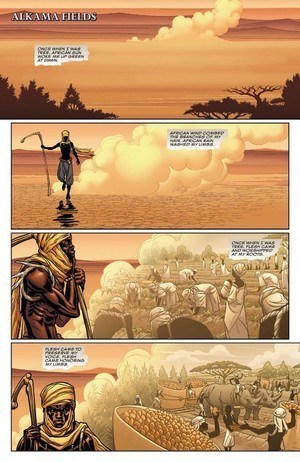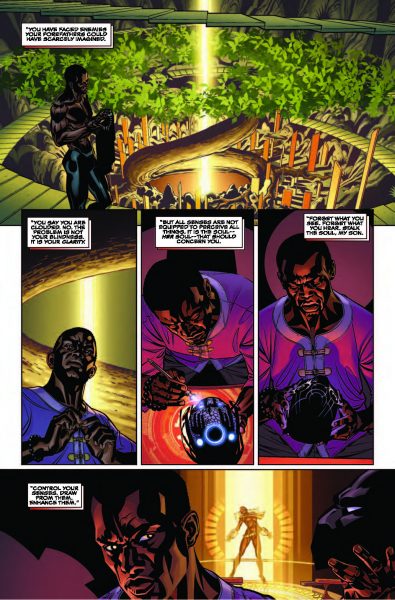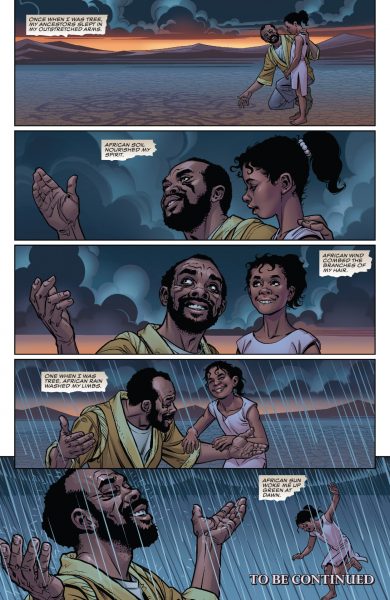Black Panther #3 Review
"A Kingdom Divided"
After the impressive
first issue of
Black Panther and a mixed second,
Black Panther #3 features a combination of elements that elevates it toward excellence again. A challenge with a single comic book – and any story, really – is to combine plot, character and text (i.e. dialog and narration) in a way in which all three are strengths that when combined push the story to new heights.
Black Panther #3 succeeds in all three areas, thanks to writer Ta-Nehisi Coates, along with quite good art from Brian Steelfreeze.

In
Black Panther #3, there are numerous story lines, but the one central to T’Challa is that he is losing the faith of his people while also losing a bit of his control on his mind. On one front, he faces the the Midnight Angels – Ayo and Aneka, former members of the elite guard Dora Milaje and possessors of powerful armor. Meanwhile, T’challa feels sorrow and confusion at the loss of his sister, Shuri, who currently is neither dead nor alive but in some type of spirit purgatory called The Djalia. If that is not enough, Black Panther confronts Tetu, a powerful opponent who feels T'challa has failed his country.
Black Panther #3 opens with a 4-page sequence with Tetu describing the evolution of Wakanda, and how it has lost its way. These pages feature beautiful writing from Coates, and demonstrate perhaps best what he provides that most comic book writers don’t – a gifted sense of lyricism. That talent of poetic writing usually extends to dialog as well. Though this can at times make the series feel unnatural, as if it is a play, it mostly works. When Coates offers a vibrant passage like the one at the start of
Black Panther #3, though it’s so good that it overcomes any questions about style choices.

Coates has also established, even through three issues, a number of interesting characters. T’challa has a great history, but Coates is finding a new wrinkle on the character as the noble but flawed ruler. The Midnight Angels also confront new obstacles and revelations in
Black Panther #3 that make them reevaluate their approach in a major way. This was also the first time in the series in which Tetu was for me a player worth attention. There are examples of strong motivation for all of these characters as well.
Brian Stelfreeze demonstrates his talent again in
Black Panther #3. Perhaps the series’ secret weapon, his action sequences and intricate backgrounds counterbalance Coates’ complex storytelling. Stelfreeze also shines during the opening passage that I mentioned earlier, giving readers panels that draw one in while the prose slowly works. On the flip side, the story is very involved and can be occasionally confusing. This may have something to do with the sometimes-awkward pacing, which is the one element that reveals Coates’ newness to the medium.

Still, the strengths of
Black Panther #3 really outshine the more pointed criticisms. While the series is not for all comic readers, it does offer a combination of story and writing approaches that few other Marvel comics ever have. Additionally, the sales of the first two issues have been outstanding (
Black Panther #1 is the highest-selling comic of 2016 so far). While there have been many compelling plot threads unveiled during the first three issues, it will be up to Coates and Stelfreeze to bring those together into a satisfying arc conclusion and extend them into future stories. So far, however, the series has been very good, and
Black Panther #3 is a very strong comic.
Pros
- Coates' writing is poetic and effective
- The art of Stelfreeze provides an effective counter to the complex story
- A number of characters that feel compelling and have interesting directions
Cons
- The pacing is abrupt at times
 In Black Panther #3, there are numerous story lines, but the one central to T’Challa is that he is losing the faith of his people while also losing a bit of his control on his mind. On one front, he faces the the Midnight Angels – Ayo and Aneka, former members of the elite guard Dora Milaje and possessors of powerful armor. Meanwhile, T’challa feels sorrow and confusion at the loss of his sister, Shuri, who currently is neither dead nor alive but in some type of spirit purgatory called The Djalia. If that is not enough, Black Panther confronts Tetu, a powerful opponent who feels T'challa has failed his country.
Black Panther #3 opens with a 4-page sequence with Tetu describing the evolution of Wakanda, and how it has lost its way. These pages feature beautiful writing from Coates, and demonstrate perhaps best what he provides that most comic book writers don’t – a gifted sense of lyricism. That talent of poetic writing usually extends to dialog as well. Though this can at times make the series feel unnatural, as if it is a play, it mostly works. When Coates offers a vibrant passage like the one at the start of Black Panther #3, though it’s so good that it overcomes any questions about style choices.
In Black Panther #3, there are numerous story lines, but the one central to T’Challa is that he is losing the faith of his people while also losing a bit of his control on his mind. On one front, he faces the the Midnight Angels – Ayo and Aneka, former members of the elite guard Dora Milaje and possessors of powerful armor. Meanwhile, T’challa feels sorrow and confusion at the loss of his sister, Shuri, who currently is neither dead nor alive but in some type of spirit purgatory called The Djalia. If that is not enough, Black Panther confronts Tetu, a powerful opponent who feels T'challa has failed his country.
Black Panther #3 opens with a 4-page sequence with Tetu describing the evolution of Wakanda, and how it has lost its way. These pages feature beautiful writing from Coates, and demonstrate perhaps best what he provides that most comic book writers don’t – a gifted sense of lyricism. That talent of poetic writing usually extends to dialog as well. Though this can at times make the series feel unnatural, as if it is a play, it mostly works. When Coates offers a vibrant passage like the one at the start of Black Panther #3, though it’s so good that it overcomes any questions about style choices.
 Coates has also established, even through three issues, a number of interesting characters. T’challa has a great history, but Coates is finding a new wrinkle on the character as the noble but flawed ruler. The Midnight Angels also confront new obstacles and revelations in Black Panther #3 that make them reevaluate their approach in a major way. This was also the first time in the series in which Tetu was for me a player worth attention. There are examples of strong motivation for all of these characters as well.
Brian Stelfreeze demonstrates his talent again in Black Panther #3. Perhaps the series’ secret weapon, his action sequences and intricate backgrounds counterbalance Coates’ complex storytelling. Stelfreeze also shines during the opening passage that I mentioned earlier, giving readers panels that draw one in while the prose slowly works. On the flip side, the story is very involved and can be occasionally confusing. This may have something to do with the sometimes-awkward pacing, which is the one element that reveals Coates’ newness to the medium.
Coates has also established, even through three issues, a number of interesting characters. T’challa has a great history, but Coates is finding a new wrinkle on the character as the noble but flawed ruler. The Midnight Angels also confront new obstacles and revelations in Black Panther #3 that make them reevaluate their approach in a major way. This was also the first time in the series in which Tetu was for me a player worth attention. There are examples of strong motivation for all of these characters as well.
Brian Stelfreeze demonstrates his talent again in Black Panther #3. Perhaps the series’ secret weapon, his action sequences and intricate backgrounds counterbalance Coates’ complex storytelling. Stelfreeze also shines during the opening passage that I mentioned earlier, giving readers panels that draw one in while the prose slowly works. On the flip side, the story is very involved and can be occasionally confusing. This may have something to do with the sometimes-awkward pacing, which is the one element that reveals Coates’ newness to the medium.
 Still, the strengths of Black Panther #3 really outshine the more pointed criticisms. While the series is not for all comic readers, it does offer a combination of story and writing approaches that few other Marvel comics ever have. Additionally, the sales of the first two issues have been outstanding (Black Panther #1 is the highest-selling comic of 2016 so far). While there have been many compelling plot threads unveiled during the first three issues, it will be up to Coates and Stelfreeze to bring those together into a satisfying arc conclusion and extend them into future stories. So far, however, the series has been very good, and Black Panther #3 is a very strong comic.
Still, the strengths of Black Panther #3 really outshine the more pointed criticisms. While the series is not for all comic readers, it does offer a combination of story and writing approaches that few other Marvel comics ever have. Additionally, the sales of the first two issues have been outstanding (Black Panther #1 is the highest-selling comic of 2016 so far). While there have been many compelling plot threads unveiled during the first three issues, it will be up to Coates and Stelfreeze to bring those together into a satisfying arc conclusion and extend them into future stories. So far, however, the series has been very good, and Black Panther #3 is a very strong comic.